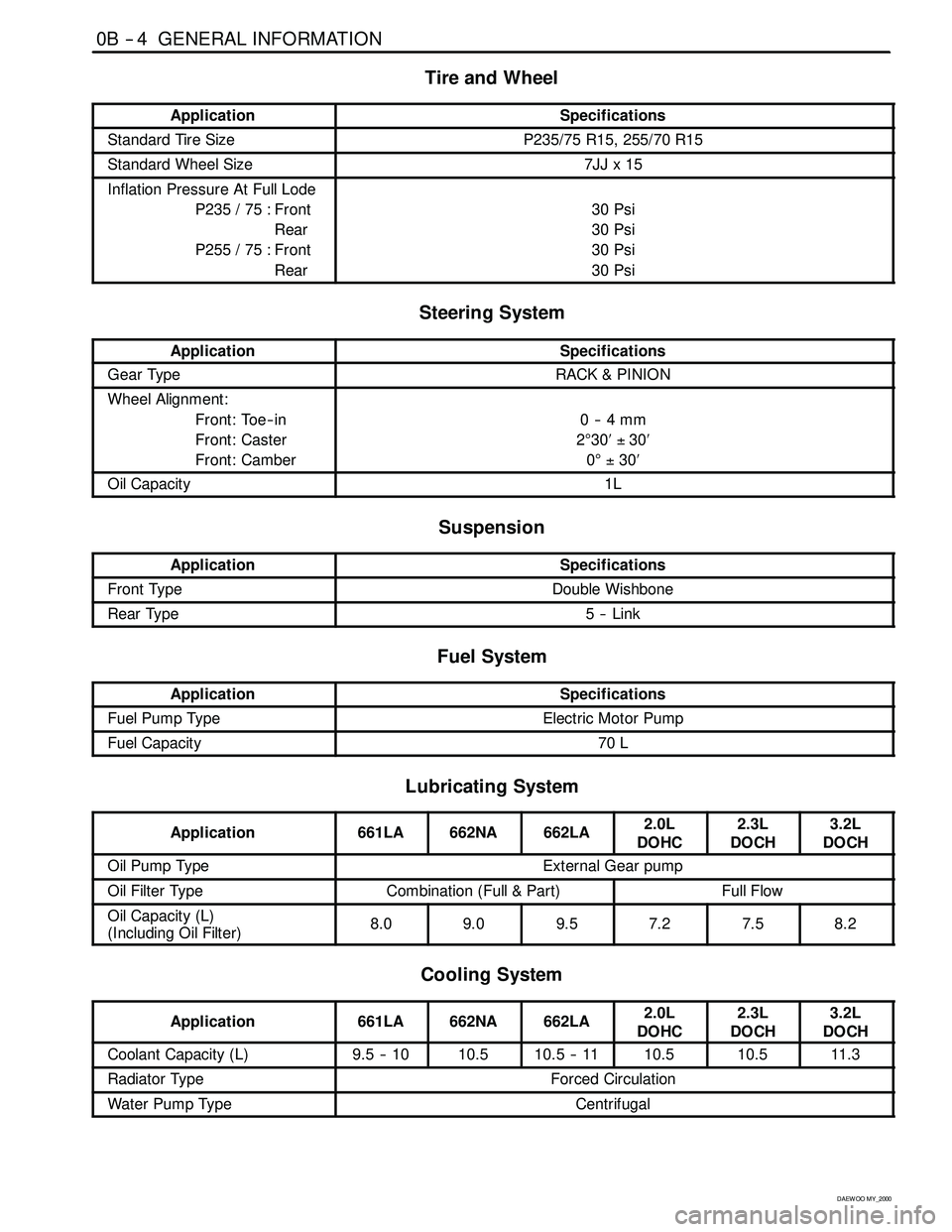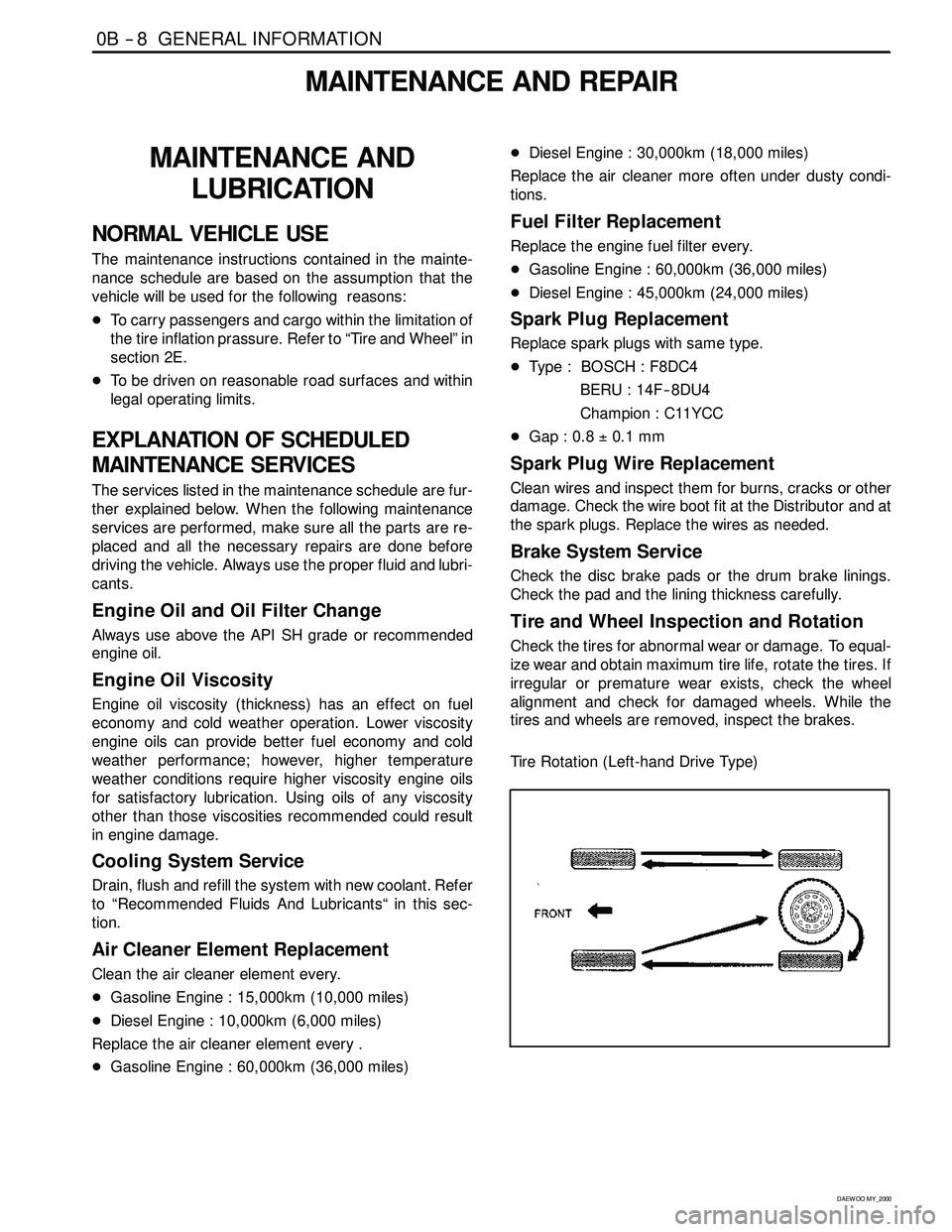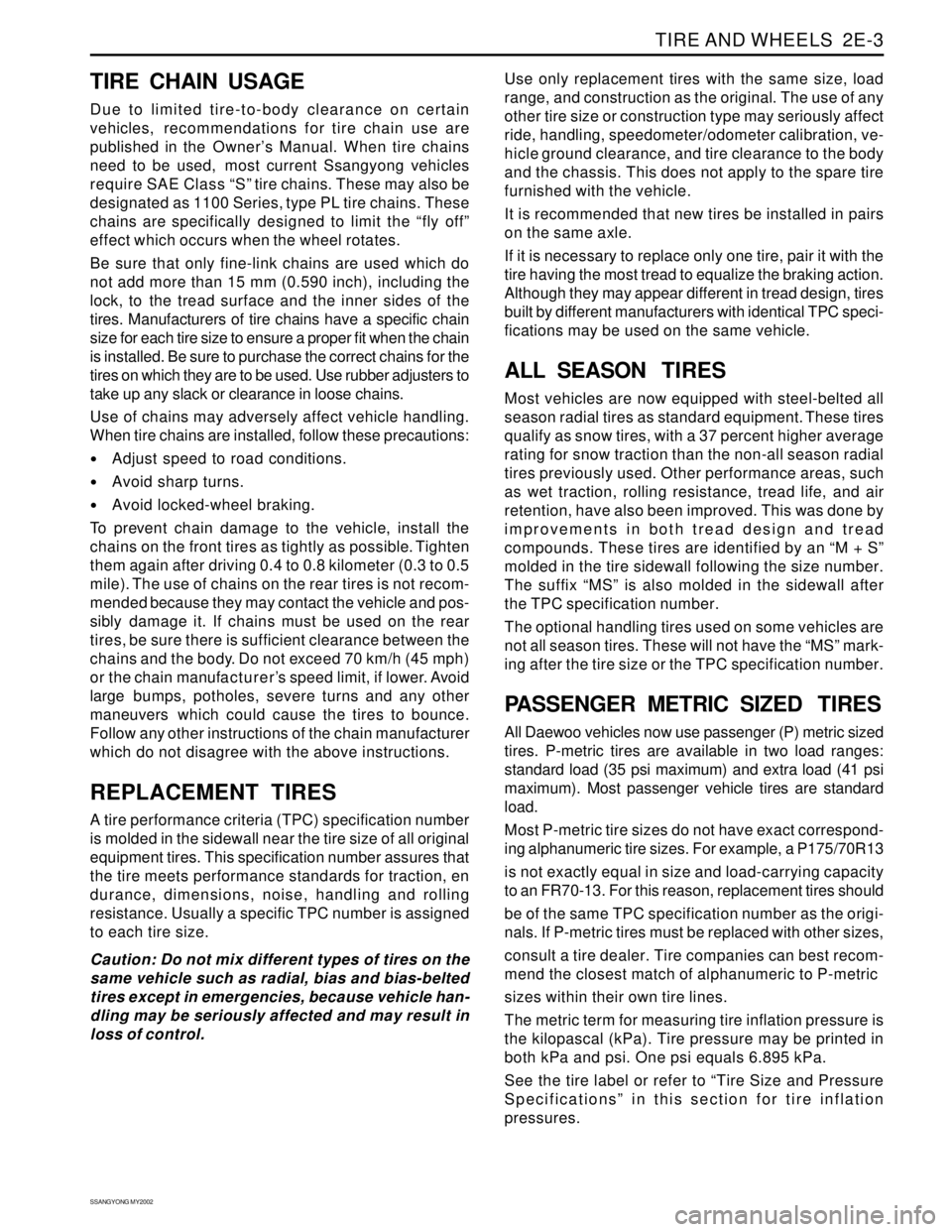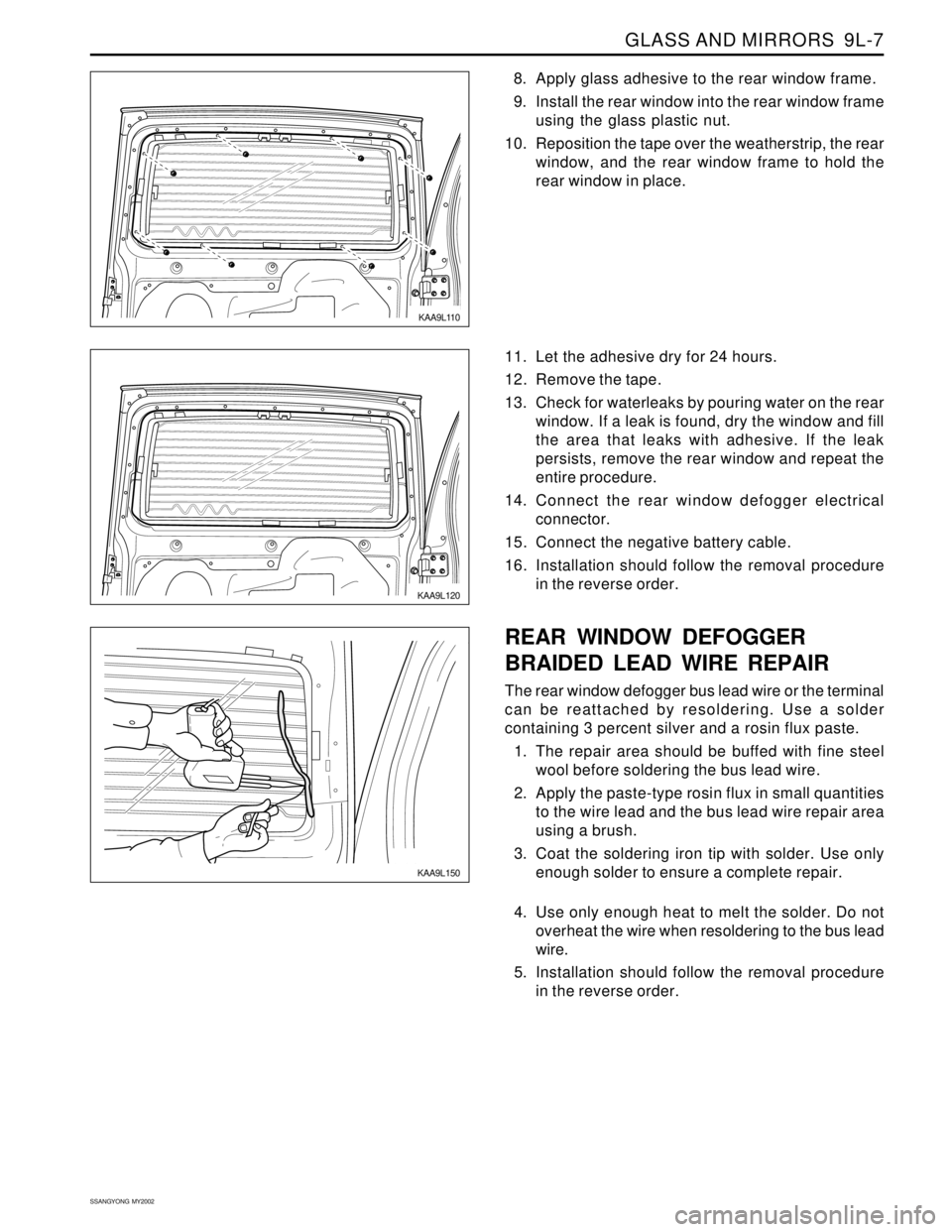tire type SSANGYONG KORANDO 1997 Service Repair Manual
[x] Cancel search | Manufacturer: SSANGYONG, Model Year: 1997, Model line: KORANDO, Model: SSANGYONG KORANDO 1997Pages: 2053, PDF Size: 88.33 MB
Page 4 of 2053

0B -- 4 GENERAL INFORMATION
D AEW OO M Y_2000
Tire and Wheel
ApplicationSpecifications
Standard Tire SizeP235/75 R15, 255/70 R15
Standard Wheel Size7JJx15
Inflation Pressure At Full Lode
P235 / 75 : Front
Rear
P255 / 75 : Front
Rear
30 Psi
30 Psi
30 Psi
30 Psi
Steering System
ApplicationSpecifications
Gear TypeRACK & PINION
Wheel Alignment:
Front: Toe -- in
Front: Caster
Front: Camber
0--4mm
2°30′±30′
0°±30′
Oil Capacity1L
Suspension
ApplicationSpecifications
Front TypeDouble Wishbone
Rear Type5--Link
Fuel System
ApplicationSpecifications
Fuel Pump TypeElectric Motor Pump
Fuel Capacity70 L
Lubricating System
Application661LA662NA662LA2.0L
DOHC2.3L
DOCH3.2L
DOCH
Oil Pump TypeExternal Gear pump
Oil Filter TypeCombination (Full & Part)Full Flow
Oil Capacity (L)
(Including Oil Filter)8.09.09.57.27.58.2
Cooling System
Application661LA662NA662LA2.0L
DOHC2.3L
DOCH3.2L
DOCH
Coolant Capacity (L)9.5 -- 1010.510.5 -- 1110.510.511. 3
Radiator TypeForced Circulation
Water Pump TypeCentrifugal
Page 8 of 2053

0B -- 8 GENERAL INFORMATION
D AEW OO M Y_2000
MAINTENANCE AND REPAIR
MAINTENANCE AND
LUBRICATION
NORMAL VEHICLE USE
The maintenance instructions contained in the mainte-
nance schedule are based on the assumption that the
vehicle will be used for the following reasons:
DTo carry passengers and cargo within the limitation of
the tire inflation prassure. Refer to “Tire and Wheel” in
section 2E.
DTo be driven on reasonable road surfaces and within
legal operating limits.
EXPLANATION OF SCHEDULED
MAINTENANCE SERVICES
The services listed in the maintenance schedule are fur-
ther explained below. When the following maintenance
services are performed, make sure all the parts are re-
placed and all the necessary repairs are done before
driving the vehicle. Always use the proper fluid and lubri-
cants.
Engine Oil and Oil Filter Change
Always use above the API SH grade or recommended
engine oil.
Engine Oil Viscosity
Engine oil viscosity (thickness) has an effect on fuel
economy and cold weather operation. Lower viscosity
engine oils can provide better fuel economy and cold
weather performance; however, higher temperature
weather conditions require higher viscosity engine oils
for satisfactory lubrication. Using oils of any viscosity
other than those viscosities recommended could result
in engine damage.
Cooling System Service
Drain, flush and refill the system with new coolant. Refer
to “Recommended Fluids And Lubricants“ in this sec-
tion.
Air Cleaner Element Replacement
Clean the air cleaner element every.
DGasoline Engine : 15,000km (10,000 miles)
DDiesel Engine : 10,000km (6,000 miles)
Replace the air cleaner element every .
DGasoline Engine : 60,000km (36,000 miles)DDiesel Engine : 30,000km (18,000 miles)
Replace the air cleaner more often under dusty condi-
tions.
Fuel Filter Replacement
Replace the engine fuel filter every.
DGasoline Engine : 60,000km (36,000 miles)
DDiesel Engine : 45,000km (24,000 miles)
Spark Plug Replacement
Replace spark plugs with same type.
DType : BOSCH : F8DC4
BERU : 14F-- 8DU4
Champion : C11YCC
DGap : 0.8±0.1 mm
Spark Plug Wire Replacement
Clean wires and inspect them for burns, cracks or other
damage. Check the wire boot fit at the Distributor and at
the spark plugs. Replace the wires as needed.
Brake System Service
Check the disc brake pads or the drum brake linings.
Check the pad and the lining thickness carefully.
Tire and Wheel Inspection and Rotation
Check the tires for abnormal wear or damage. To equal-
ize wear and obtain maximum tire life, rotate the tires. If
irregular or premature wear exists, check the wheel
alignment and check for damaged wheels. While the
tires and wheels are removed, inspect the brakes.
Tire Rotation (Left-hand Drive Type)
Page 856 of 2053

SSANGYONG MY2002
2E-2 TIRE AND WHEELS
TIRE AND WHEEL BALANCING
There are two types of tire and wheel balancing: static
and dynamic.
Static balance is the equal distribution of weight around
the wheel. Assemblies that are statically unbalanced
cause a bouncing action called wheel tramp. This condi-
tion may eventually cause uneven tire wear.
DESCRIPTION AND OPERATION
Dynamic balance is the equal distribution of weight on
each side of the centerline so that when the assembly
spins there is no tendency for it to move from side to
side. Assemblies that are dynamically unbalanced may
cause wheel shimmy.
KAA2E010
KAA2E020
General Balance Precautions
Remove all deposits of foreign material from the inside
of the wheel.
Caution: Remove stones from the tread in order to
avoid operator injury during spin balancing.
Inspect the tire for any damage. Balance the tire accord-
ing to the equipment manufacturer’s recommendations.
KAA2E030
Wheel Weights
If more than 85 grams (3.0 ounces) are needed to static
balance the wheel, split the wheel weights as equally
as possible between the inboard and the outboard
flanges.
Balancing the assemblies with factory alloy wheels re
quires the use of special nylon-coated, clip-on wheel
weights. These weights are designed to fit over the
thicker rim flange of the alloy wheel. Install these
weights with a plastictipped hammer.
Adhesive wheel weights are also available. Use the
following procedure to install adhesive wheel weights.
Page 857 of 2053

TIRE AND WHEELS 2E-3
SSANGYONG MY2002
TIRE CHAIN USAGE
Due to limited tire-to-body clearance on certain
vehicles, recommendations for tire chain use are
published in the Owner’s Manual. When tire chains
need to be used, most current Ssangyong vehicles
require SAE Class “S” tire chains. These may also be
designated as 1100 Series, type PL tire chains. These
chains are specifically designed to limit the “fly off”
effect which occurs when the wheel rotates.
Be sure that only fine-link chains are used which do
not add more than 15 mm (0.590 inch), including the
lock, to the tread surface and the inner sides of the
tires. Manufacturers of tire chains have a specific chain
size for each tire size to ensure a proper fit when the chain
is installed. Be sure to purchase the correct chains for the
tires on which they are to be used. Use rubber adjusters to
take up any slack or clearance in loose chains.
Use of chains may adversely affect vehicle handling.
When tire chains are installed, follow these precautions:
Adjust speed to road conditions.
Avoid sharp turns.
Avoid locked-wheel braking.
To prevent chain damage to the vehicle, install the
chains on the front tires as tightly as possible. Tighten
them again after driving 0.4 to 0.8 kilometer (0.3 to 0.5
mile). The use of chains on the rear tires is not recom-
mended because they may contact the vehicle and pos-
sibly damage it. If chains must be used on the rear
tires, be sure there is sufficient clearance between the
chains and the body. Do not exceed 70 km/h (45 mph)
or the chain manufacturer’s speed limit, if lower. Avoid
large bumps, potholes, severe turns and any other
maneuvers which could cause the tires to bounce.
Follow any other instructions of the chain manufacturer
which do not disagree with the above instructions.
REPLACEMENT TIRES
A tire performance criteria (TPC) specification number
is molded in the sidewall near the tire size of all original
equipment tires. This specification number assures that
the tire meets performance standards for traction, en
durance, dimensions, noise, handling and rolling
resistance. Usually a specific TPC number is assigned
to each tire size.
Caution: Do not mix different types of tires on the
same vehicle such as radial, bias and bias-belted
tires except in emergencies, because vehicle han-
dling may be seriously affected and may result in
loss of control.Use only replacement tires with the same size, load
range, and construction as the original. The use of any
other tire size or construction type may seriously affect
ride, handling, speedometer/odometer calibration, ve-
hicle ground clearance, and tire clearance to the body
and the chassis. This does not apply to the spare tire
furnished with the vehicle.
It is recommended that new tires be installed in pairs
on the same axle.
If it is necessary to replace only one tire, pair it with the
tire having the most tread to equalize the braking action.
Although they may appear different in tread design, tires
built by different manufacturers with identical TPC speci-
fications may be used on the same vehicle.
ALL SEASON TIRES
Most vehicles are now equipped with steel-belted all
season radial tires as standard equipment. These tires
qualify as snow tires, with a 37 percent higher average
rating for snow traction than the non-all season radial
tires previously used. Other performance areas, such
as wet traction, rolling resistance, tread life, and air
retention, have also been improved. This was done by
improvements in both tread design and tread
compounds. These tires are identified by an “M + S”
molded in the tire sidewall following the size number.
The suffix “MS” is also molded in the sidewall after
the TPC specification number.
The optional handling tires used on some vehicles are
not all season tires. These will not have the “MS” mark-
ing after the tire size or the TPC specification number.
PASSENGER METRIC SIZED TIRES
All Daewoo vehicles now use passenger (P) metric sized
tires. P-metric tires are available in two load ranges:
standard load (35 psi maximum) and extra load (41 psi
maximum). Most passenger vehicle tires are standard
load.
Most P-metric tire sizes do not have exact correspond-
ing alphanumeric tire sizes. For example, a P175/70R13
is not exactly equal in size and load-carrying capacity
to an FR70-13. For this reason, replacement tires should
be of the same TPC specification number as the origi-
nals. If P-metric tires must be replaced with other sizes,
consult a tire dealer. Tire companies can best recom-
mend the closest match of alphanumeric to P-metric
sizes within their own tire lines.
The metric term for measuring tire inflation pressure is
the kilopascal (kPa). Tire pressure may be printed in
both kPa and psi. One psi equals 6.895 kPa.
See the tire label or refer to “Tire Size and Pressure
Specifications” in this section for tire inflation
pressures.
Page 858 of 2053

SSANGYONG MY2002
2E-4 TIRE AND WHEELS
TIRE LABEL
The tire label is permanently located on the rear face
of the driver’s door and should be referred to for tire
information. It lists the maximum vehicle load, the tire
size (including the spare tire), and the cold inflation
pressure (including the spare tire).
S PARE TIRE
This vehicle comes equipped with a full-sized spare
tire and wheel.
The temporary spare tire is designed for emergency
use only. The original tire should be repaired or replaced
at the first opportunity and reinstall.
WHEELS
Wheels must be replaced if they are bent, dented, have
excessive lateral or radial runout, leak air through
welds, have elongated bolt holes, or if the wheel bolts
won’t stay tight or are heavily rusted. Wheels with
excessive runout may cause vehicle vibration.
Replacement wheels must be equivalent to the original
equipment wheels in load capacity, diameter, rim width,
offset, and mounting configuration. A wheel of improper
size or type may affect wheel and bearing life, brake
cooling, speedometer/odometer calibration, vehicle
ground clearance, and tire clearance to the body and
the chassis. The wheel offset is 49 ± 1 (1.93 ± 0.04
inches). Steel wheels may be identified by a two- or
three-letter code stamped into the rim near the valve
stem. Alloy wheels should have the code, the part
number, and the manufacturer ID cast into the back
side.
INFLATION OF TIRES
The pressure recommended for any vehicle line is care-
fully calculated to give a satisfactory ride, handling,
tread life, and load-carrying capacity.
Tire pressure should be checked monthly or before any
extended trip. Check the tires when they are cold, after
the vehicle has sat for 3 hours or more or has been
driven less than 1 mile. Set the tire pressure to the
specifications on the tire label located on the rear face
of the drive r ’s door. Tire inflation pressure is also given
under “Tire Size and Pressure Specifications” in
this section.
Valve caps or extensions should be on the valves to
keep dust and water out.
For sustained driving at speeds up to 140 km/h (85 mph),
inflate the tires to the pressure recommended on the
tire. Sustained driving at speeds faster than 140 km/h
(85 mph), even if permitted by law, is not advised unless
the vehicle has special high-speed tires available from
many tire dealers. Tire pressures may increase as much
as 41 kPa (6 psi) when the tires are hot.
Higher than recommended tire pressure can cause
Hard ride.
Tire bruising or damage.
Rapid tread wear at the center of the tire.
Lower than recommended pressure can cause
Tire squeal on turns.
Hard steering.
Rapid and uneven wear on the edges of the tread.
Tire rim bruises and rupture.
Tire cord breakage.
High tire temperatures.
Unequal tire pressures on same axle can cause
Uneven braking.
Steering lead.
Reduced handling.
Swerve on acceleration.
Torque steer.
Page 1789 of 2053

GLASS AND MIRRORS 9L-7
SSANGYONG MY2002
KAA9L120
11. Let the adhesive dry for 24 hours.
12. Remove the tape.
13. Check for waterleaks by pouring water on the rear
window. If a leak is found, dry the window and fill
the area that leaks with adhesive. If the leak
persists, remove the rear window and repeat the
entire procedure.
14. Connect the rear window defogger electrical
connector.
15. Connect the negative battery cable.
16. Installation should follow the removal procedure
in the reverse order.
KAA9L110
8. Apply glass adhesive to the rear window frame.
9. Install the rear window into the rear window frame
using the glass plastic nut.
10. Reposition the tape over the weatherstrip, the rear
window, and the rear window frame to hold the
rear window in place.
KAA9L150
REAR WINDOW DEFOGGER
BRAIDED LEAD WIRE REPAIR
The rear window defogger bus lead wire or the terminal
can be reattached by resoldering. Use a solder
containing 3 percent silver and a rosin flux paste.
1. The repair area should be buffed with fine steel
wool before soldering the bus lead wire.
2. Apply the paste-type rosin flux in small quantities
to the wire lead and the bus lead wire repair area
using a brush.
3. Coat the soldering iron tip with solder. Use only
enough solder to ensure a complete repair.
4. Use only enough heat to melt the solder. Do not
overheat the wire when resoldering to the bus lead
wire.
5. Installation should follow the removal procedure
in the reverse order.